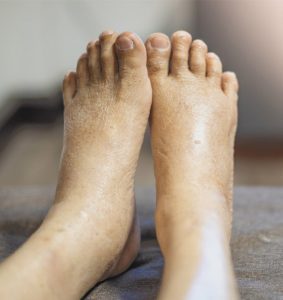

The first step: diagnosis of diabetes. Once diagnosed with diabetes, routine follow up with your PCP is imperative to get your blood sugar under control. Next, find a podiatrist for routine care who can also educate you on preventative measures. Regular foot screenings can be lifesaving and limb saving for the diabetic population. Your Podiatrist will also screen for other risk factors that can contribute to the development of diabetic foot infections and/or amputations. If the proper health and lifestyles changes are made, many of the potential health risks are preventable or controllable. Some common risk factors include high blood sugars, high blood pressure, smoking, callouses/corns, foot deformity, poor blood flow, history of ulcers or previous amputations, vision loss, kidney disease and neuropathy. Working together with you, your PCP and other medical professionals, can significantly reduce your risk of amputation.
Ulcers are a primary cause of developing complicated foot infections, hospitalization, or amputation. Many ulcers start as a simple callous. As a diabetic with some degree of neuropathy, you may not feel a callous progressing into an open wound, missing the early signs of an infection. Without prompt treatment, this unnoticed wound or infection could quickly extend to the bone or progress to a limb threatening infection that will likely require hospitalization and amputation. This is why routine foot screenings are so important for the diabetic population.
In addition to routine foot screenings, self-inspection should be performed daily. Check your feet daily for blisters, cuts, sores, redness, swelling or any other abnormal changes. Make sure to also look between your toes. Many podiatrists recommend the use of white socks to their patients. White socks make it easier to notice blood or drainage coming from the foot. Patients should wear socks that pull moisture away from the skin like cotton or special acrylic fibers, avoiding nylon. Avoid socks with seams that irritate your skin. If you can’t reach your feet, ask someone for assistance or try using a foot mirror. Do not try to remove calluses or other foot lesions yourself and avoid walking barefoot. Other suggested recommendations include: avoiding worn down shoes, shoes that are too small or too narrow for your foot, and quit smoking. If you notice any abnormalities, contact your podiatrist or medical provider right away.
Together, we can change lives by saving limbs.
Family Foot & Leg Center
Isin Mustafa
(833) 366-8534
(FOOT LEG)
www.NaplesPodiatrist.com
3161 Harbor Blvd, Suite B
Port Charlotte, FL 33952
 Southwest Florida's Health and Wellness Magazine Health and Wellness Articles
Southwest Florida's Health and Wellness Magazine Health and Wellness Articles

